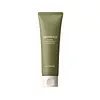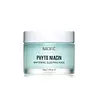What's inside
What's inside
 Key Ingredients
Key Ingredients

 Benefits
Benefits

 Concerns
Concerns

 Ingredients Side-by-side
Ingredients Side-by-side

Phormium Tenax Root Extract 67%
Skin ConditioningGlycerin
HumectantMethyl Trimethicone
Skin ConditioningButylene Glycol
HumectantVegetable Oil
Skin ConditioningTrehalose
HumectantWater
Skin Conditioning1,2-Hexanediol
Skin ConditioningCeramide NP
Skin ConditioningPhytosphingosine
Skin ConditioningVitis Vinifera Seed Oil
EmollientRibes Nigrum Seed Oil
EmollientCalendula Officinalis Flower Extract
MaskingRibes Nigrum Fruit Extract
AstringentPhormium Tenax Extract
Skin ConditioningPhormium Tenax Seed Oil
Skin ConditioningHelianthus Annuus Seed Oil
EmollientSodium Hyaluronate
HumectantMelia Azadirachta Leaf Extract
Skin ConditioningMelia Azadirachta Flower Extract
Skin ConditioningCoccinia Indica Fruit Extract
Skin ConditioningAloe Barbadensis Flower Extract
EmollientSolanum Melongena Fruit Extract
Skin ConditioningPortulaca Oleracea Extract
Skin ConditioningSimmondsia Chinensis Seed Oil
EmollientOcimum Sanctum Leaf Extract
Skin ConditioningCurcuma Longa Root Extract
MaskingCorallina Officinalis Extract
Skin ConditioningHippophae Rhamnoides Oil
EmollientJojoba Esters
EmollientAmmonium Acryloyldimethyltaurate/Beheneth-25 Methacrylate Crosspolymer
Emulsion StabilisingPalmitic Acid
EmollientStearic Acid
CleansingHydroxyethyl Acrylate/Sodium Acryloyldimethyl Taurate Copolymer
Emulsion StabilisingAcrylates/C10-30 Alkyl Acrylate Crosspolymer
Emulsion StabilisingArginine
MaskingXanthan Gum
EmulsifyingDisodium EDTA
Sorbitan Isostearate
EmulsifyingHydrogenated Lecithin
EmulsifyingMyristic Acid
CleansingTocopherol
AntioxidantParfum
MaskingPhormium Tenax Root Extract 67%, Glycerin, Methyl Trimethicone, Butylene Glycol, Vegetable Oil, Trehalose, Water, 1,2-Hexanediol, Ceramide NP, Phytosphingosine, Vitis Vinifera Seed Oil, Ribes Nigrum Seed Oil, Calendula Officinalis Flower Extract, Ribes Nigrum Fruit Extract, Phormium Tenax Extract, Phormium Tenax Seed Oil, Helianthus Annuus Seed Oil, Sodium Hyaluronate, Melia Azadirachta Leaf Extract, Melia Azadirachta Flower Extract, Coccinia Indica Fruit Extract, Aloe Barbadensis Flower Extract, Solanum Melongena Fruit Extract, Portulaca Oleracea Extract, Simmondsia Chinensis Seed Oil, Ocimum Sanctum Leaf Extract, Curcuma Longa Root Extract, Corallina Officinalis Extract, Hippophae Rhamnoides Oil, Jojoba Esters, Ammonium Acryloyldimethyltaurate/Beheneth-25 Methacrylate Crosspolymer, Palmitic Acid, Stearic Acid, Hydroxyethyl Acrylate/Sodium Acryloyldimethyl Taurate Copolymer, Acrylates/C10-30 Alkyl Acrylate Crosspolymer, Arginine, Xanthan Gum, Disodium EDTA, Sorbitan Isostearate, Hydrogenated Lecithin, Myristic Acid, Tocopherol, Parfum
Water
Skin ConditioningButylene Glycol
HumectantNiacinamide 5%
SmoothingCyclopentasiloxane
EmollientGlycerin
Humectant1,2-Hexanediol
Skin ConditioningCyclohexasiloxane
EmollientDimethicone
EmollientAmmonium Acryloyldimethyltaurate/Vp Copolymer
Trehalose
HumectantPolyglyceryl-3 Methylglucose Distearate
EmulsifyingTromethamine
BufferingDimethicone/Vinyl Dimethicone Crosspolymer
Skin ConditioningPEG-20 Sorbitan Cocoate
EmulsifyingCarbomer
Emulsion StabilisingButyrospermum Parkii Butter
Skin ConditioningOlea Europaea Fruit Oil
MaskingCaprylic/Capric Triglyceride
MaskingSqualane
EmollientHydrogenated Lecithin
EmulsifyingDimethiconol
EmollientDisodium EDTA
Melia Azadirachta Leaf Extract
Skin ConditioningMelia Azadirachta Flower Extract
Skin ConditioningCoccinia Indica Fruit Extract
Skin ConditioningSolanum Melongena Fruit Extract
Skin ConditioningSodium Hyaluronate
HumectantAloe Barbadensis Flower Extract
EmollientEchinacea Angustifolia Leaf Extract
MoisturisingHydrolyzed Sodium Hyaluronate
Skin ConditioningHydrolyzed Hyaluronic Acid
HumectantHyaluronic Acid
HumectantRosa Damascena Flower Water
MaskingCeramide NP
Skin ConditioningCholesterol
EmollientSodium Hyaluronate Crosspolymer
HumectantHydroxypropyltrimonium Hyaluronate
Ocimum Sanctum Leaf Extract
Skin ConditioningPhytosphingosine
Skin ConditioningSodium Acetylated Hyaluronate
HumectantCurcuma Longa Root Extract
MaskingCorallina Officinalis Extract
Skin ConditioningCentella Asiatica Extract
CleansingCamellia Sinensis Leaf Extract
AntimicrobialPentylene Glycol
Skin ConditioningMadecassoside
AntioxidantHippophae Rhamnoides Fruit Extract
Skin ConditioningWater, Butylene Glycol, Niacinamide 5%, Cyclopentasiloxane, Glycerin, 1,2-Hexanediol, Cyclohexasiloxane, Dimethicone, Ammonium Acryloyldimethyltaurate/Vp Copolymer, Trehalose, Polyglyceryl-3 Methylglucose Distearate, Tromethamine, Dimethicone/Vinyl Dimethicone Crosspolymer, PEG-20 Sorbitan Cocoate, Carbomer, Butyrospermum Parkii Butter, Olea Europaea Fruit Oil, Caprylic/Capric Triglyceride, Squalane, Hydrogenated Lecithin, Dimethiconol, Disodium EDTA, Melia Azadirachta Leaf Extract, Melia Azadirachta Flower Extract, Coccinia Indica Fruit Extract, Solanum Melongena Fruit Extract, Sodium Hyaluronate, Aloe Barbadensis Flower Extract, Echinacea Angustifolia Leaf Extract, Hydrolyzed Sodium Hyaluronate, Hydrolyzed Hyaluronic Acid, Hyaluronic Acid, Rosa Damascena Flower Water, Ceramide NP, Cholesterol, Sodium Hyaluronate Crosspolymer, Hydroxypropyltrimonium Hyaluronate, Ocimum Sanctum Leaf Extract, Phytosphingosine, Sodium Acetylated Hyaluronate, Curcuma Longa Root Extract, Corallina Officinalis Extract, Centella Asiatica Extract, Camellia Sinensis Leaf Extract, Pentylene Glycol, Madecassoside, Hippophae Rhamnoides Fruit Extract
Ingredients Explained
These ingredients are found in both products.
Ingredients higher up in an ingredient list are typically present in a larger amount.
1,2-Hexanediol is a synthetic liquid and another multi-functional powerhouse.
It is a:
- Humectant, drawing moisture into the skin
- Emollient, helping to soften skin
- Solvent, dispersing and stabilizing formulas
- Preservative booster, enhancing the antimicrobial activity of other preservatives
Aloe Barbadensis Flower Extract is an extract of the flowers of the aloe, Aloe barbadensis, Liliaceae
Aloe contains the antioxidants Vitamins A, C, and E.
It also contains sugars in the form of monosaccharides and polysaccharides, folic acid, choline, many common minerals such as calcium, 12 anthraquinones, fatty acids, amino acids, and Vitamin B12.
Aloe is known to be anti-inflammatory, moisturizing, antiseptic, healing, and protect against UV rays.
Learn more about Aloe Barbadensis Flower ExtractButylene Glycol (or BG) is used within cosmetic products for a few different reasons:
Overall, Butylene Glycol is a safe and well-rounded ingredient that works well with other ingredients.
Though this ingredient works well with most skin types, some people with sensitive skin may experience a reaction such as allergic rashes, closed comedones, or itchiness.
Learn more about Butylene GlycolCeramide NP is a type of ceramide and formally known as ceramide 3.
Ceramides are intercellular lipids naturally found in our skin that bonds dead skin cells together to create a barrier. They are known for their ability to hold water and thus are a great ingredient for dry skin.
Ceramides are an important building block for our skin barrier. A stronger barrier helps the skin look more firm and hydrated. By bolstering the skin ceramides act as a barrier against irritating ingredients. This can help with inflammation as well.
If you would like to eat ceramides, sweet potatoes contain a small amount.
Read more about other common types of ceramides here:
Ceramide AP
Ceramide EOP
Coccinia Indica Fruit Extract is also known as Ivy Gourd Fruit Extract. It has skin conditioning properties.
Corallina Officinalis Extract is from the red seaweed, Corallina Officinalis. This seaweed is found all over the world but is most common in the rocky shores of Great Britain and Ireland.
Corallina Officinalis Extract contains antioxidant and emollient properties.
Extracted polysaccharides, galactose and xylose, in red algae showed antioxidant activity. Antioxidants help with anti-aging by neutralizing free-radical molecules. Free-radical molecules may damage your skin cells and DNA. Galactose is also a PHA.
Corallina Officinalis is structurally similar to coral due to its high calcium content.
Learn more about Corallina Officinalis ExtractCurcuma Longa Root Extract is from the spice, turmeric. Besides being a healthy and delicious spice, turmeric also has plenty of skincare benefits. It has anti-inflammatory, antioxidant, and anti-microbial properties.
Turmeric contains curcumin, an antioxidant. Antioxidants help neutralize unstable free-radical molecules. Free-radical molecules may damage your skin's cells and DNA. Curcumin may help with anti-aging.
Curcumin also has anti-inflammatory properties and can help soothe skin and reduce irritation. On top of that, curcumin has been shown to help prevent hyperpigmentation from sun damage.
The anti-microbial property of turmeric can make it effective in treating acne. This property has also been shown to help regulate the production of sebum.
Learn more about Curcuma Longa Root ExtractDisodium EDTA plays a role in making products more stable by aiding other preservatives.
It is a chelating agent, meaning it neutralizes metal ions that may be found in a product.
Disodium EDTA is a salt of edetic acid and is found to be safe in cosmetic ingredients.
Learn more about Disodium EDTAGlycerin is already naturally found in your skin. It helps moisturize and protect your skin.
A study from 2016 found glycerin to be more effective as a humectant than AHAs and hyaluronic acid.
As a humectant, it helps the skin stay hydrated by pulling moisture to your skin. The low molecular weight of glycerin allows it to pull moisture into the deeper layers of your skin.
Hydrated skin improves your skin barrier; Your skin barrier helps protect against irritants and bacteria.
Glycerin has also been found to have antimicrobial and antiviral properties. Due to these properties, glycerin is often used in wound and burn treatments.
In cosmetics, glycerin is usually derived from plants such as soybean or palm. However, it can also be sourced from animals, such as tallow or animal fat.
This ingredient is organic, colorless, odorless, and non-toxic.
Glycerin is the name for this ingredient in American English. British English uses Glycerol/Glycerine.
Learn more about GlycerinHydrogenated Lecithin is created from the hydrogenation of lecithin (a group of phospholipids). Hydrogenation is a chemical reaction between hydrogen and another element.
This ingredient is an emollient and emulsifier. As an emollient, it helps soften skin by trapping moisture within. As an emulsifier, it prevents oil and water ingredients from separating.
Melia Azadirachta Flower Extract is from the Neem tree. Neem trees originate from India.
Melia Azadirachta Flower Extract contains antioxidants. Antioxidants help fight free-radicals. Free-radicals are molecules that may damage your skin cells, such as pollution.
The flowers of this tree are lilac colored.
Learn more about Melia Azadirachta Flower ExtractMelia Azadirachta Leaf Extract is extract from the neem plant.
The leaves of this tree contain flavonoids and polyphenols. These two compounds are antioxidants, anti-inflammatory, and antibacterial. Further research is needed as to their effects when applied on skin.
Ocimum Sanctum Leaf Extract comes from the Holy Basil plant. Holy Basil is native to India.
Holy Basil is rich in antioxidants due to its high romarinic acid, ferulic acid, and rutin content. This gives it skin brightening and soothing properties.
While Holy Basil has many claims to help fight acne, more research is needed.
One thing to note is the presence of tannins; tannins are naturally found in nature. However, this compound may be skin-sensitizing.
Learn more about Ocimum Sanctum Leaf ExtractPhytosphingosine is a phospholipid naturally found in our skin as a building block for ceramides.. It helps moisturize, soothe, and protect skin.
Phytosphingosine contributes to your skin's natural moisturizing factor (NMF). The NMF is responsible for hydration, a strong barrier, and plasticity. Our NMF decreases with age. Increasing NMF leads to more healthy and hydrated skin.
Studies show products formulated with NMF ingredients help strengthen our skin's barrier. Having a healthy skin barrier reduces irritation and increases hydration. Our skin barrier is responsible for having plump and firm skin. It also helps protect our skin against infection, allergies, and inflammation.
Fun fact: Phytosphingosine is abundant in plants and fungi.
More ingredients that help boost collagen in skin:
Learn more about PhytosphingosineSodium Hyaluronate is hyaluronic acid's salt form. It is commonly derived from the sodium salt of hyaluronic acid.
Like hyaluronic acid, it is great at holding water and acts as a humectant. This makes it a great skin hydrating ingredient.
Sodium Hyaluronate is naturally occurring in our bodies and is mostly found in eye fluid and joints.
These are some other common types of Hyaluronic Acid:
Learn more about Sodium HyaluronateWe don't have a description for Solanum Melongena Fruit Extract yet.
Trehalose is a disaccharide made of two glucose molecules (glucose is sugar!). Trehalose is used to help moisturize skin. It also has antioxidant properties.
As a humectant, trehalose helps draw moisture from the air to your skin. This helps keep your skin hydrated.
Due to its antioxidant properties, trehalose may help with signs of aging. Antioxidants help fight free-radical molecules, unstable molecules that may damage your skin.
In medicine, trehalose and hyaluronic acid are used to help treat dry eyes.
Some animals, plants, and bacteria create trehalose as a source of energy to survive freeze or lack of water.
Learn more about TrehaloseWater. It's the most common cosmetic ingredient of all. You'll usually see it at the top of ingredient lists, meaning that it makes up the largest part of the product.
So why is it so popular? Water most often acts as a solvent - this means that it helps dissolve other ingredients into the formulation.
You'll also recognize water as that liquid we all need to stay alive. If you see this, drink a glass of water. Stay hydrated!
Learn more about Water